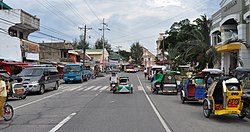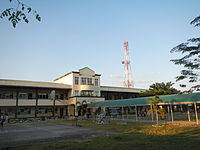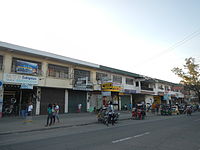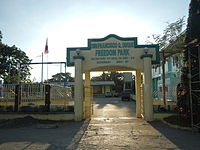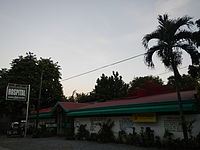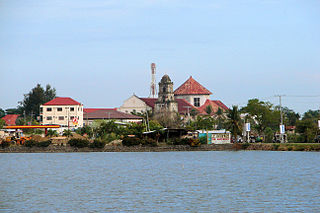
Binmaley, officially the Municipality of Binmaley, is a 1st class municipality in the province of Pangasinan, Philippines. According to the 2020 census, it has a population of 86,881 people.

Anda, officially the Municipality of Anda, is a 3rd class municipality in the province of Pangasinan, Philippines. Unique in this part of the province, The Sambalic language of Bolinao or Binubolinao is primarily spoken in the municipality and the adjacent town of Bolinao. According to the 2020 census, it has a population of 41,548 people.
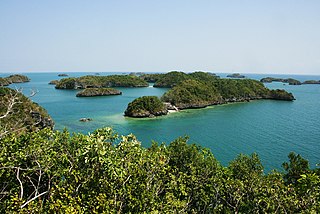
Pangasinan, officially the Province of Pangasinan, is a coastal province in the Philippines located in the Ilocos Region of Luzon. Its capital is Lingayen. Pangasinan is in the western area of Luzon along Lingayen Gulf and the South China Sea. It has a total land area of 5,451.01 square kilometres (2,104.65 sq mi). According to the 2020 census it has a population of 3,163,190. The official number of registered voters in Pangasinan is 1,651,814. The western portion of the province is part of the homeland of the Sambal people, while the central and eastern portions are the homeland of the Pangasinan people. Due to ethnic migration, the Ilocano people settled in the province.

Agno, officially the Municipality of Agno, is a 3rd class municipality in the province of Pangasinan, Philippines. According to the 2020 census, it has a population of 29,947 people.

Bani, officially the Municipality of Bani, is a 2nd class municipality in the province of Pangasinan, Philippines. According to the 2020 census, it has a population of 52,603 people.

Bautista, officially the Municipality of Bautista, is a 4th class municipality in the province of Pangasinan, Philippines. According to the 2020 census, it has a population of 35,398 people.

Binalonan, officially the Municipality of Binalonan, is a 1st class municipality in the province of Pangasinan, Philippines. According to the 2020 census, it has a population of 56,382 people.
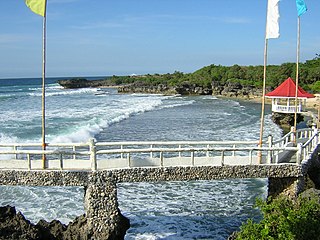
Bolinao, officially the Municipality of Bolinao, is a 1st class municipality in the province of Pangasinan, Philippines. According to the 2020 census, it has a population of 83,979 people.

Bugallon, officially the Municipality of Bugallon, is a 2nd class municipality in the province of Pangasinan, Philippines. According to the 2020 census, it has a population of 74,962 people.

Burgos, officially the Municipality of Burgos, is a 4th class municipality in the province of Pangasinan, Philippines. According to the 2020 census, it has a population of 23,749 people.

Infanta, officially the Municipality of Infanta, is a 3rd class municipality in the province of Pangasinan, Philippines. According to the 2020 census, it has a population of 26,242 people.

Labrador, officially the Municipality of Labrador, is a 4th class municipality in the province of Pangasinan, Philippines. According to the 2020 census, it has a population of 26,811 people.

Lingayen, officially the Municipality of Lingayen, is a 1st class municipality and capital of the province of Pangasinan, Philippines. According to the 2020 census, it has a population of 107,728 people.

Manaoag, officially the Municipality of Manaoag, is a 1st class municipality in the province of Pangasinan, Philippines. According to the 2020 census, it has a population of 76,045 people.

Pozorrubio, officially the Municipality of Pozorrubio, is a 1st class municipality in the province of Pangasinan, Philippines. According to the 2020 census, it has a population of 74,729 people.

Santa Barbara, officially the Municipality of Santa Barbara, is a 1st class municipality in the province of Pangasinan, Philippines. According to the 2020 census, it has a population of 92,187 people.

Santa Maria, officially the Municipality of Santa Maria, is a 4th class municipality in the province of Pangasinan, Philippines. According to the 2020 census, it has a population of 34,220 people.

Santo Tomas, officially the Municipality of Santo Tomas, is a 5th class municipality in the province of Pangasinan, Philippines. According to the 2020 census, it has a population of 14,878 people.

Sual, officially the Municipality of Sual, is a 1st class municipality in the province of Pangasinan, Philippines. According to the 2020 census, it has a population of 39,091 people.

Nampicuan, officially the Municipality of Nampicuan, is a 5th class municipality in the province of Nueva Ecija, Philippines. According to the 2020 census, it has a population of 14,471 people.
